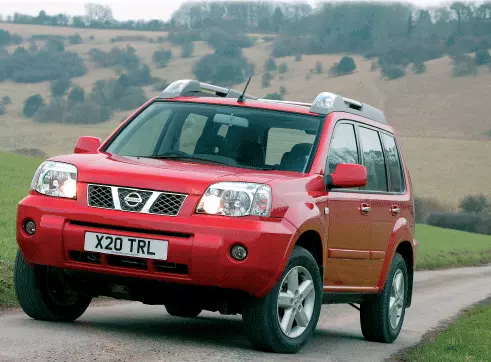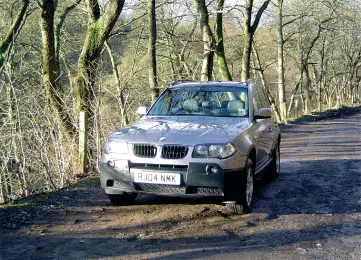X-traordinary
Paul Talbot adjudicates as two of motoring’s big guns go head to head in another battle of the 4x4s.
For our final 4x4 test of this series, we pitched the Nissan X Trail against the BMW X3 to see which one had the bigger 'X-tra Factor' . . .
The Nissan ventured the X Trail into the market in 2001 and it has become the best selling 4x4 in Europe. The model range comes in four formats; the SE, Sport, SVE and the one we tested, the T Spec. Our first impressions of the car were that it was a well-constructed sturdy vehicle but we
weren't sure whether we liked the centrally-located binnacle on the dashboard which houses the speedometer and other driver information. It also struck us as a big car but we thought
we'd soon get used to it. We also wondered whether the darkened windows looked sinister!
Exterior 
Sitting on 215 size tyres with 16” stylish alloys, it seems quite a high car but we soon got used to it. This T Spec model has safari lamps in the roof bars that seemed a bit extreme.
However, together with the car's personal number plate, they soon became a bit of a talking point. 
A chunky bumper with foglamps makes an immediate impact at the front as do the protruding wheel arches. Our car came in black metallic paintwork and together with its polished alloys and darkened windows it looked exceptional. The car has quite a high waistline and a large glazed area to both sides which provides good visibility. A short stubby aerial can be found at the front of the car, and at the back there's an element of déjà vu, as it looks distinctly Volvo V50 at the rear with its tall tail lights which narrow towards the top. A roof spoiler can be specified to top it off if required.
Checking out the vehicle's accessibility for storage and transporting of large objects, we found that the useable boot space is approximately 1000mm wide and 800mm to ground floor level. The car has an internal floor area of 950 mm from back of rear seat. Height: 1655mm; Length: 4510mm; Width: 1765mm.
Interior 
We had a leather interior on this car which also had heated seats and, as we have pointed out previously, they're great for people with back problems. Getting behind the wheel of the car was initially a bit of a challenge but once used to it, it posed no further problems. The seats were electrically operated so moving them backwards and forwards was no effort and they were
remarkably comfortable. As with most 4x4s, a commanding view of the road ahead is easy to get accustomed to and this car is no different.
The interior layout wasn't to our taste initially; the centrally -located speedometer and rev counter/ fuel gauge can be difficult to read at a glance but as with other aspects of the car, we soon got used to it. The car can easily be used in either two or four wheel drive by the touch of a button and other features fell easily to hand; we particularly liked the simplicity of the air conditioning and the satellite navigation unit. The Sat Nav has big buttons and a joystick-type control housed in a silver background which can all be mastered in minutes.
Looking around the front passenger compartment of the car it's obvious that it features plenty of storage units although we found that the door pockets were too small to carry the usual odds and ends that we carry. There are two cup holders up front too, of course!
A single CD player is standard fit as are steering wheel controls making for safe driving. Our usual three other backseat guinea pig passengers had no complaints from the rear offering
comments of plenty of legroom and comfortable seats. So that's a positive note.
On the road 
For a car that can be used off road and on-road it's a very capable performer. We took it along some poor quality narrow roads in the course of the day job and it tackled all with ease and comfort. The car also features traction control as part of its ESP+ facility that also has stability properties and adds to its safety when on the road. The vehicle's manoeuvrability in tight
spots is easy and on our regular test route, it was distinctly better than the rest of the 4x4s we've tested up to now with aquiet ride and a punchy, 2.5 litre engine that pulls away very easily and wants to keep on going and going. 
The steering is light and accurate enabling it to be placed wherever required. That said, it's no sports car in terms of handling but it's quite acceptable and is surprisingly car-like to drive. We like that. However, does the X Trail beat the BMW?
Technical Information
Max power output: 121/165 bhp at 6000 rpm
Max torque: 170/230 at 4000 rpm
Max speed: 111 mph
0-60 time: 11.1 seconds
Kerb weight: 1,490 - 1,546
Towable mass: 2000 kg
Fuel consumption Urban: 22.2
Extra Urban: 35.8
Combined: 29.4 mpg
BMW suggest that the X3 has no competitors and provides an alternative niche market vehicle to that of the 3 Series for the young couple that may want to explore the great outdoors with their rural pursuit lifestyle. We think the car will join the growing number of 4x4s used on public
roads for its elevated driving position and off-road capability.
This particular car is a top of the range 3.0i SE vehicle but the range begins with a 2.0d and various other engines are available; 2.0d SE, 2.5i SE, 2.5i Sport, 3.0i SE and 3.0i Sport.
Our first impressions are that it's a well-screwed together vehicle with a comfortable driving position and is similar in style to Toyota's RAV 4 in size. We were slightly surprised to find
that the steering was heavier than expected. Would it live up to the expectations of the blue propeller premium brand marque?
Exterior 
The car is quite big at 4.565 m in length, 1.987 m width and 1.674 m in height but it doesn't feel as big as others we've tested in this series. BMW's flame surfacing styling has yet to reach the X3 and it's more like a large 3-series estate sitting on 18-inch star spoke alloy wheels which are a cost option. The car has the trademark kidney grille and a chunky appearance.
Our car came in a metallic silver and there's no doubt it caused a stir wherever it went, but this might be due to the fact that it's a relatively recent launch and models are a rare sight.
During our time with the car we only spotted two others on the road. The car has a moderately high waistline and it's not unattractive but we're not so sure about the kicked up rear window
line towards the back of the car. Chrome detailing around the glass lifts the exterior and as with other 4x4s, roof rails top off the roof of the car. Thankfully, front and rear parking sensors
were fitted as standard equipment and whilst over-sensitive, kept trouble at bay.
Interior 
Accessing the car was challenging but the doors opened widely for anyone needing access from a wheelchair. Passengers however reported that the protruding side sill makes entry awk-ward; a degree of agility and nimbleness would be required.
Our car had a three-quarter length electrically-operated sunroof (a £975 cost option) together with a full blind which led to a light and airy cabin that also benefited from buffed aluminium
effect trim on the door handles and fascia.
Digging deeper into the options list, the full leather trim was nice to sit in, if a little cold when we had the car in November, but it does make it feel extra special and therefore worth it.
Setting the car up for a suitable driving position was an absolute doddle; the steering has reach and rake adjustment and the seats themselves give good support for those of us with bad
backs and good under thigh support. A range of options for raising and lowering the seat were offered, but we were rather surprised to find that on a car nudging £38,500, electricallyoperated
seats were not standard kit. To add to the comfort, the car's climate control could be adjusted with user-friendly large buttons to provide the perfect environment.
Entertainment was provided by the BMW Business radio and single-slot CD player with optional multichanger fitted between the front seats; a great location from an accessibility point of view. Needless to say the sound quality was exemplary and worth the £275 it adds to the options list.
On the downside, we tried several times to retain the random setting on the CD player but failed – it might have been our technique but we had to resort to resetting it several times during the course of the week which was annoying. We did, however, like the steering wheel-mounted controls.
Usefully, the car was also fitted with cruise control and an integrated bluetooth telephone system – a sensible addition in our on-the-move society. This model features satellite navigation
too, which in common with other BMWs, is fairly easy to use – difficult at first but once familiar, it's easy.
For rear seat passengers, two of the three seats were comfortable but foot space for the central occupant is hampered by the transmission tunnel that runs down the centre of the car. We were disappointed to find that the rear seats don't fold totally flat, which is a shame when much cheaper similar vehicles can fold seats into the floor and a number of other combinations
are available.
On the road 
It's very car-like to drive and after a few miles, it's easy to forget that you're in a 4x4 apart from the elevated driving position which at its lowest setting was great and still gave a good view of the road.
We felt that the 3.0 engine wasn't as powerful as the one in the recently tested Z4. The engine
appeared to need to be kept above 2,500 rpm to maintain some pace but the car is exceptionally
quiet when doing more mundane manoeuvres in cities. The test route posed no problems either, except that on poor surfaces it feels unsettled and ride quality suffers appreciably.
As a motorway cruiser, though, it's excellent, helped no doubt by cruise control. The turn-in
was good with direct steering, though on the heavy side.
Technical Information
Max power output: 121/165 bhp at 6000 rpm
Max torque: 170/230 at 4000 rpm
Max speed: 130 mph
0-60 time: 8.1 seconds
Kerb weight: 1,760 kg
Towable mass: 2000 kg
Fuel consumption Urban: 16.2
Extra Urban: 31
Combined: 23.3 mpg
Verdict 
Both are excellent cars – the BMW is trying to introduce another variant to its extremely successful X5 range and give its customers a choice of lifestyle vehicle. Both cars have
excellent cabins but also their associated access problems which is to be expected with a 4x4, but we'd have to go for the Nissan as the winner; it has better ride quality, a larger wheelchair/
mobility space in the boot and the minor matter of being around £15,000 cheaper.
The range for the Nissan X Trail starts at £16,995 and the BMW starts at £29,000. The models tested in each case were the T Spec for the Nissan and the X3's 3.0 derivative.
Thanks to Martin Harrison at BMW and Terry Steeden at Nissan. Contact Nissan on 0800 731 9633 or at www.nissan.co.uk. and BMW on 0800 325600 or at www.bmw.co.uk.
The Disabled Drivers' Motor Club wants you to spend your money wisely. There are a number of assessment centres around the UK for you to discuss your mobility requirements and we urge you to contact them before you commit your funds to a vehicle that may not be suitable. See pages 14-15 of the DDMC Annual Handbook for details of your nearest centre. 
|

